Monitoring¶
Host Check Command¶
The module provides a CLI command to check a host’s certificate. It does so by fetching all the necessary information from this module’s own database.
Usage¶
General: icingacli x509 check host [options]
Options:
--ip A hosts IP address
--host A hosts name
--port The port to check in particular
--warning Less remaining time results in state WARNING [25%]
--critical Less remaining time results in state CRITICAL [10%]
--allow-self-signed Ignore if a certificate or its issuer has been self-signed
Threshold Definition¶
Thresholds can either be defined relative (in percent) or absolute (time interval). Time intervals consist of a digit and an accompanying unit (e.g. “3M” are three months). Supported units are:
| Identifier | Description |
|---|---|
| y, Y | Year |
| M | Month |
| d, D | Day |
| h, H | Hour |
| m | Minute |
| s, S | Second |
Example:
$ icingacli x509 check host --host example.org --warning 1y
WARNING - *.example.org expires in 219 days|'*.example.org'=18985010s;25574400;10281600;0;102470399
Performance Data¶
The command outputs a performance data value for each certificate that is served by the host. The value measured is the amount of seconds remaining until the certificate expires.

The value of max is the total amount of seconds the certificate is valid.
warning and critical are the seconds remaining after which the respective
state is reported.
Icinga 2 Integration¶
First off, this chapter relies on the fact that you’re using the Director already and that you’re familiar with some of the terms and functionalities used there.
If you don’t want to use the Director, know that Icinga 2 already provides an appropriate template for the host check command in its template library: https://icinga.com/docs/icinga2/latest/doc/10-icinga-template-library/#x509
Director Import Sources¶
The module provides two different import sources:
Hosts (X509)¶
Focuses on the hosts the module found when scanning the networks. Use this for the most straightforward way of integrating the results into your environment. It’s also the utilized source in the example further below.
Columns provided by this source:
| Name | Description |
|---|---|
| host_name_or_ip | Default key column. This is primarily host_name, though if this is not unique it falls back to host_ip for individual results |
| host_ip | A host’s IP address by which it is known to this module. May be IPv4 or IPv6 |
| host_name | A host’s name as detected by SNI or a reverse DNS lookup during the scan process |
| host_ports | Separated by comma. All ports where certificates were found |
| host_address | Set to host_ip if it is IPv4 else null |
| host_address6 | Set to host_ip if it is IPv6 else null |
Services (X509)¶
While the hosts import source does not provide any details about the found certificates this one does. This also means that this source may generate multiple results for a single host since it focuses on the found certificates.
Use this source if you want to import service objects directly and relate them to already existing hosts by their utilized certificates. The Director’s many utilities provided in this regard will again come in handy here.
Columns provided by this source:
| Name | Description |
|---|---|
| host_name_ip_and_port | Default key column. This is a combination of host_name, host_ip and host_port in the format name/ip:port |
| host_ip | A host’s IP address by which it is known to this module. May be IPv4 or IPv6 |
| host_name | A host’s name as detected by SNI or a reverse DNS lookup during the scan process |
| host_port | A host’s port where a certificate has been found |
| host_address | Set to host_ip if it is IPv4 else null |
| host_address6 | Set to host_ip if it is IPv6 else null |
| cert_subject | A certificate’s common name |
| cert_issuer | The issuer’s common name |
| cert_self_signed | Whether the certificate is self-signed (y or n) |
| cert_trusted | Whether the certificate is trusted (y or n) |
| cert_valid_from | The certificate’s start time of validity (UNIX timestamp) |
| cert_valid_to | The certificate’s end time of validity (UNIX timestamp) |
| cert_fingerprint | The certificate’s fingerprint (hex-encoded) |
| cert_dn | The certificate’s distinguished name |
| cert_subject_alt_name | The certificate’s alternative subject names (Comma separated pairs of type:name) |
Service Checks With the Hosts Import Source¶
This example covers the setup of service checks by using a particular host template and suggests then two options utilizing service apply rules.
Preparations¶
Assuming the check command definition icingacli-x509 has already been imported
you need to define a few data fields now:
| Field name | Data type |
|---|---|
| certified_ports | Array |
| icingacli_x509_ip | String |
| icingacli_x509_host | String |
| icingacli_x509_port | String |
| icingacli_x509_warning | String |
| icingacli_x509_critical | String |
| icingacli_x509_allow_self_signed | Boolean |
Then please create a new host template with a name of your choosing. We’ve chosen
x509-host. We’re also importing our base template base-host here which defines
all the default properties of our hosts.
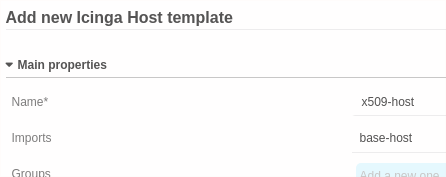
This host template also requires three data fields which are shown below.

A service template is also needed. We chose the name x509-host-check and
icingacli-x509 as check command.
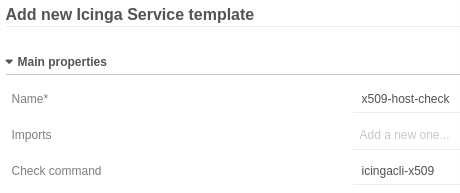
The service template now requires all data fields which correspond to the check command’s parameters.
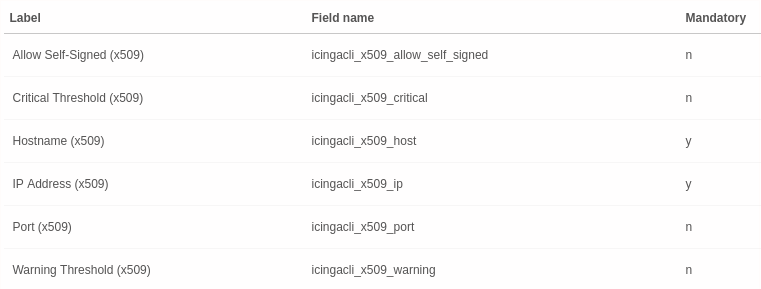
Import Source Setup¶
Create a new import source of type Hosts (X509).
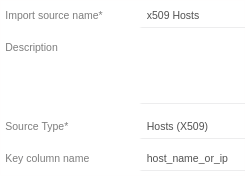
Configure a property modifier for column host_ports of type Split and use
the comma , as delimiter.
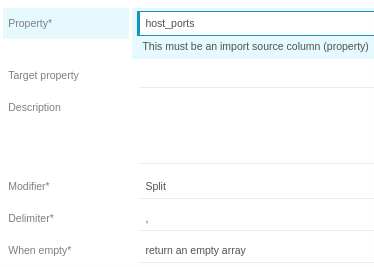
The preview should now produce a similar result to this:

Sync Rule Setup¶
Create a new sync rule for objects of type Host. Depending on your environment
you may choose either Merge or Replace as update policy. Choose Merge to
continue with this example.
Which properties this rule defines is also very dependent on what you want to
achieve. We now assume that you already have host objects whose object names
match exactly those the import source provides. (Hence you should choose
Merge as update policy)
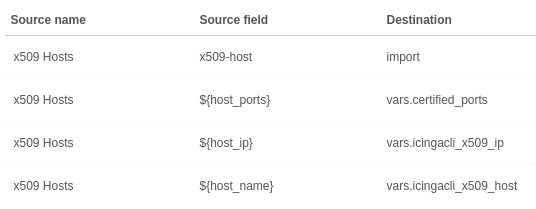
Service Check Setup¶
There are two choices now. The first checks a host’s certificates as a single service. The second creates for each individual certificate (port) a service.
Single Service¶
This is done by defining a new service as part of the host template created earlier. There add a service and choose the service template also created previously.
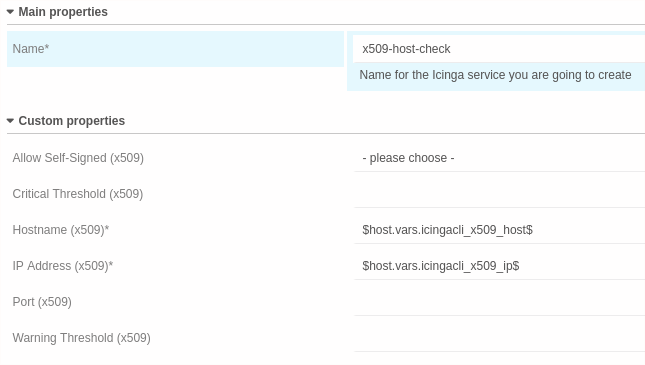
Once you’ve triggered the import and synchronisation as well as deployed the resulting changes you should see this in Icinga Web 2:
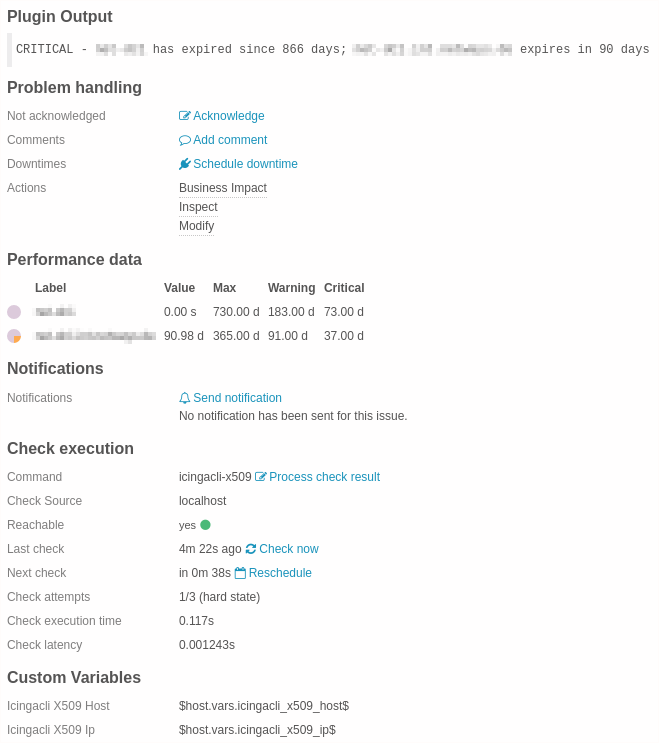
Multiple Services¶
This utilizes a service apply rule. Trigger the import and synchronisation first, otherwise you can’t choose a custom variable for the apply for rule.
Once the synchronisation is finished, set up the service apply rule like this:

After deploying the resulting changes you should see this in Icinga Web 2:
